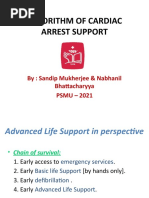Algorithm of Resuscitation Care
Uploaded by
jyothiAlgorithm of Resuscitation Care
Uploaded by
jyothiPost-resuscitation Care
(ROSC and comatose)
Airway and Breathing
Maintain SpO 2 94 – 98%
Advanced airway
Waveform capnography
Ventilate lungs to normocapnia
Immediate treatment
Circulation
12-lead ECG
Obtain reliable intravenous access
Aim for SBP > 100 mmHg
Fluid (crystalloid) – restore normovolaemia
Intra-arterial blood pressure monitoring
Consider vasopressor/ inotrope to maintain SBP
Control temperature
Constant temperature 32 oC – 36 oC
Sedation; control shivering
Likely cardiac cause?
No Yes
ST elevation on 12 lead ECG?
Diagnosis
No Yes
Consider Coronary
Coronary angiography ± PCI
angiography ± PCI
Consider CT brain No Cause for cardiac arrest
and/or CTPA identified?
Yes
Treat non-cardiac cause of
Admit to Intensive Care Unit
cardiac arrest
ICU management
Temperature control: constant temperature 32 oC – 36 oC for ≥ 24 h; prevent fever for at least 72 h
Maintain normoxia and normocapnia; protective ventilation
Optimising recovery
Optimise haemodynamics (MAP, lactate, ScvO 2, CO/CI, urine output)
Echocardiography
Maintain normoglycaemia
Diagnose/treat seizures (EEG, sedation, anticonvulsants)
Delay prognostication for at least 72 h
Secondary prevention
e.g. ICD, screen for inherited Follow-up and rehabilitation
disorders, risk factor management
You might also like
- Electrophysiological Maneuvers For Arrhythmia Analysis-Cardiotext Publishing (2014)100% (2)Electrophysiological Maneuvers For Arrhythmia Analysis-Cardiotext Publishing (2014)211 pages
- Faisalabad Institute of Cardiology, Faisalabad.: Discharge SlipNo ratings yetFaisalabad Institute of Cardiology, Faisalabad.: Discharge Slip1 page
- Topnotch Emergency Medicine For Moonlighters100% (1)Topnotch Emergency Medicine For Moonlighters129 pages
- Adult Cardiac Arrest Algorithm: VF/PVT Asystole/PEA100% (4)Adult Cardiac Arrest Algorithm: VF/PVT Asystole/PEA8 pages
- 12-Adult Post Resuscitation Care Algorithm 2021No ratings yet12-Adult Post Resuscitation Care Algorithm 20211 page
- Post Resuscitation Care: 15 SEPTEMBER 2014100% (1)Post Resuscitation Care: 15 SEPTEMBER 201427 pages
- Patient care following resuscitation is a critical aspect of modern medicineNo ratings yetPatient care following resuscitation is a critical aspect of modern medicine8 pages
- Criticalcareofthe Post-Cardiacarrestpatient: Amy C. Walker,, Nicholas J. JohnsonNo ratings yetCriticalcareofthe Post-Cardiacarrestpatient: Amy C. Walker,, Nicholas J. Johnson10 pages
- Adult Post-Cardiac Arrest Care Algorithm: o Co Io o CoNo ratings yetAdult Post-Cardiac Arrest Care Algorithm: o Co Io o Co1 page
- ACLS Healthcare Provider Post-Cardiac Arrest Care Algorithm: o Co Io o CoNo ratings yetACLS Healthcare Provider Post-Cardiac Arrest Care Algorithm: o Co Io o Co1 page
- Neurocritical Care in The General Intensive Care UnitNo ratings yetNeurocritical Care in The General Intensive Care Unit17 pages
- Post-Cardiac - Arrest Evaluation and ManagementNo ratings yetPost-Cardiac - Arrest Evaluation and Management6 pages
- Learning Station 3 Environmental Emergency 3 Alternate: "Mysteriously Unresponsive Older Woman"No ratings yetLearning Station 3 Environmental Emergency 3 Alternate: "Mysteriously Unresponsive Older Woman"17 pages
- daniel-gonzalez-post-cardiac-arrest-care-in-theNo ratings yetdaniel-gonzalez-post-cardiac-arrest-care-in-the15 pages
- Adult Basic Life Support Algorithm For Healthcare ProvidersNo ratings yetAdult Basic Life Support Algorithm For Healthcare Providers15 pages
- Pediatric Status Epilepticus Pathway-FINALNo ratings yetPediatric Status Epilepticus Pathway-FINAL5 pages
- Post Resuscitation Disease 608 Rahul ChakrabortyNo ratings yetPost Resuscitation Disease 608 Rahul Chakraborty13 pages
- Algorithm For Helping With Cardiac ArrestNo ratings yetAlgorithm For Helping With Cardiac Arrest52 pages
- Adult Advanced Life Support: CirculationNo ratings yetAdult Advanced Life Support: Circulation48 pages
- Resuscitation: Overview of Advance Life SupportNo ratings yetResuscitation: Overview of Advance Life Support21 pages
- Cardiac Care and COVID-19: Perspectives in Medical PracticeFrom EverandCardiac Care and COVID-19: Perspectives in Medical PracticeNo ratings yet
- Pressure Sores (Bed Sores) : Presented By: Ms - Celine AntonyNo ratings yetPressure Sores (Bed Sores) : Presented By: Ms - Celine Antony40 pages
- Quality Assurance and Patient Safety Measures: A Comparative Longitudinal AnalysisNo ratings yetQuality Assurance and Patient Safety Measures: A Comparative Longitudinal Analysis8 pages
- Ensuring Accurate Blood Pressure MeasurementNo ratings yetEnsuring Accurate Blood Pressure Measurement5 pages
- COVID-19 and Its Impact On The Management of PatieNo ratings yetCOVID-19 and Its Impact On The Management of Patie6 pages
- The Stanford Hall Consensus Statement For post-COVID-19 RehabilitationNo ratings yetThe Stanford Hall Consensus Statement For post-COVID-19 Rehabilitation11 pages
- Final Approved Copy of DM Cardiac Anaesthesia Syllabus 06082012 1737 PDFNo ratings yetFinal Approved Copy of DM Cardiac Anaesthesia Syllabus 06082012 1737 PDF6 pages
- Rhetorical Analysis Reading 1, The Best Ways To Protect Your Heart NowNo ratings yetRhetorical Analysis Reading 1, The Best Ways To Protect Your Heart Now2 pages
- C98. The Role of Echocardiography As A Diagnostic Modality in Pulmonary Embolism in Intensive CareNo ratings yetC98. The Role of Echocardiography As A Diagnostic Modality in Pulmonary Embolism in Intensive Care4 pages
- Mayo Clinic Cardiology 1 - 5080272005597495314100% (2)Mayo Clinic Cardiology 1 - 50802720055974953141,112 pages
- Final Announcement SCU 7 (2016) Ok REVISI 12 NEW (Kecil)No ratings yetFinal Announcement SCU 7 (2016) Ok REVISI 12 NEW (Kecil)12 pages
- Double Outlet Right Ventricle With Non-Committed Ventricular Septal Defect and Other Complex Associated Anomalies in An Infant: Overview of The Surgical Management ApproachNo ratings yetDouble Outlet Right Ventricle With Non-Committed Ventricular Septal Defect and Other Complex Associated Anomalies in An Infant: Overview of The Surgical Management Approach11 pages




































































































